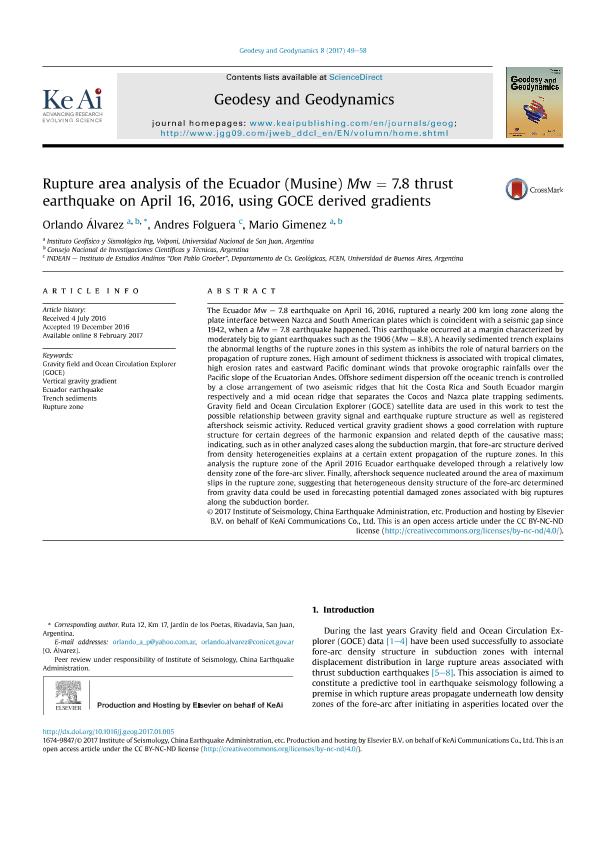Artículo
Rupture area analysis of the Ecuador (Musine) Mw = 7.8 thrust earthquake on April 16, 2016, using GOCE derived gradients
Fecha de publicación:
01/2017
Editorial:
KeAi Communications
Revista:
Geodesy and Geodynamics
ISSN:
1674-9847
Idioma:
Inglés
Tipo de recurso:
Artículo publicado
Clasificación temática:
Resumen
The Ecuador Mw = 7.8 earthquake on April 16, 2016, ruptured a nearly 200 km long zone along the plate interface between Nazca and South American plates which is coincident with a seismic gap since 1942, when a Mw = 7.8 earthquake happened. This earthquake occurred at a margin characterized by moderately big to giant earthquakes such as the 1906 (Mw = 8.8). A heavily sedimented trench explains the abnormal lengths of the rupture zones in this system as inhibits the role of natural barriers on the propagation of rupture zones. High amount of sediment thickness is associated with tropical climates, high erosion rates and eastward Pacific dominant winds that provoke orographic rainfalls over the Pacific slope of the Ecuatorian Andes. Offshore sediment dispersion off the oceanic trench is controlled by a close arrangement of two aseismic ridges that hit the Costa Rica and South Ecuador margin respectively and a mid ocean ridge that separates the Cocos and Nazca plate trapping sediments. Gravity field and Ocean Circulation Explorer (GOCE) satellite data are used in this work to test the possible relationship between gravity signal and earthquake rupture structure as well as registered aftershock seismic activity. Reduced vertical gravity gradient shows a good correlation with rupture structure for certain degrees of the harmonic expansion and related depth of the causative mass; indicating, such as in other analyzed cases along the subduction margin, that fore-arc structure derived from density heterogeneities explains at a certain extent propagation of the rupture zones. In this analysis the rupture zone of the April 2016 Ecuador earthquake developed through a relatively low density zone of the fore-arc sliver. Finally, aftershock sequence nucleated around the area of maximum slips in the rupture zone, suggesting that heterogeneous density structure of the fore-arc determined from gravity data could be used in forecasting potential damaged zones associated with big ruptures along the subduction border.
Archivos asociados
Licencia
Identificadores
Colecciones
Articulos(CCT - SAN JUAN)
Articulos de CENTRO CIENTIFICO TECNOLOGICO CONICET - SAN JUAN
Articulos de CENTRO CIENTIFICO TECNOLOGICO CONICET - SAN JUAN
Citación
Alvarez Pontoriero, Orlando; Folguera Telichevsky, Andres; Gimenez, Mario Ernesto; Rupture area analysis of the Ecuador (Musine) Mw = 7.8 thrust earthquake on April 16, 2016, using GOCE derived gradients; KeAi Communications; Geodesy and Geodynamics; 8; 1; 1-2017; 49-58
Compartir
Altmétricas




